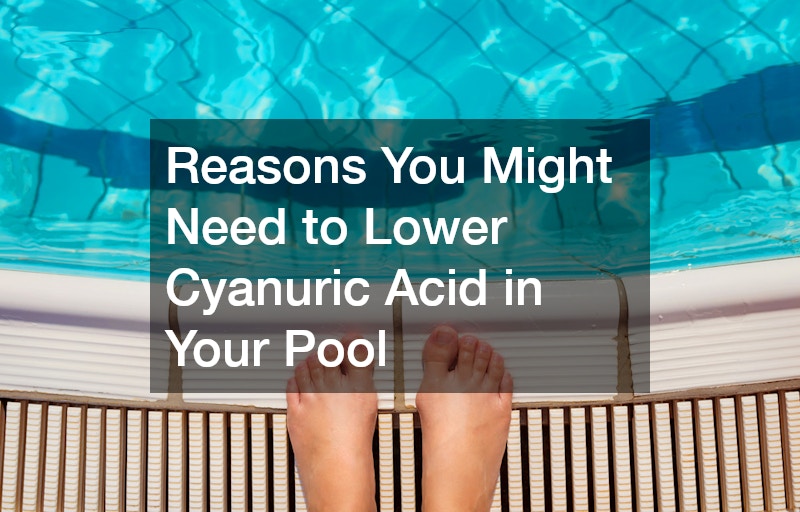There are various reasons why you might need to lower cyanuric acid in your pool. This practice is essential for keeping your water clean, safe, and enjoyable. Learn about the importance of managing this chemical to prevent issues that can arise from elevated levels.
Cyanuric Acid and Its Importance
Cyanuric acid is a chemical compound that acts as a stabilizer for chlorine in pool water. It helps by preventing the degradation of chlorine caused by UV rays from sunlight, making it an essential component for effective sanitation. Without proper levels of cyanuric acid, chlorine can dissipate quickly, making it less effective at killing bacteria and pathogens in the water.
Maintaining appropriate cyanuric acid levels not only ensures that your pool is sanitized but also enhances the overall swimming experience. When chlorine is protected from the sun, it can perform its job of keeping the water clean for longer periods, thus reducing the frequency of chemical applications. This ultimately saves you money and labor when maintaining your pool.
In summary, understanding the role of cyanuric acid is key to maintaining pool chemistry. Proper levels should be regularly monitored to ensure effective water sanitation and to create a safe swimming environment. The delicate balance it provides plays a vital part in your pool’s overall maintenance strategy.
Effects of High Cyanuric Acid Levels
Excess levels of cyanuric acid can have detrimental effects on the effectiveness of chlorine, leading to inadequate sanitation. When cyanuric acid levels are too elevated, it can create conditions where chlorine is rendered less effective at killing germs and algae, which can compromise water quality. This may result in cloudy water and an overall negative swimming experience.
In addition, high cyanuric acid levels are known to encourage algae growth, causing more frequent maintenance and potential structural damage to your pool. The presence of algae not only affects the aesthetic of your pool but can also lead to slippery surfaces that pose safety risks to swimmers. It can become a vicious cycle: as chlorine becomes less effective, more algae proliferate, which in turn requires even more chlorine.
Hence, it’s critical to monitor cyanuric acid levels regularly. Being aware of the signs and taking the necessary actions can prevent cascading problems that come from ignoring this important aspect of pool care. Addressing high levels promptly will save pool owners time, money, and resources in the long run.
Recognizing a Need to Lower Cyanuric Acid
Regular testing of pool water is crucial for maintaining proper chemical levels, including cyanuric acid. Pool testing kits are widely available and can effectively measure the levels of various chemicals in your water, helping you to identify if your cyanuric acid levels are too high. Ideally, cyanuric acid levels should be maintained between 30 and 50 ppm for optimal sanitation.
Increased swimming pool maintenance could be another indicator of high cyanuric acid levels. If you find yourself consistently battling cloudy water or if you have to apply more chlorine than usual, it may be time to check your cyanuric acid levels. Furthermore, unexpected algae growth, even after shock treatments, can be a tell-tale sign that cyanuric acid is restricting chlorine effectiveness.
Lastly, paying attention to your pool’s overall health and performance can clue you into potential problems. Regularly scheduled testing should become part of your routine in pool care, ensuring not only that cyanuric acid levels are kept in check, but also that other aspects of your pool chemistry, like pH and alkalinity, are in harmony.
Methods Used to Lower Cyanuric Acid Levels
Reducing cyanuric acid levels can be achieved through several methods, with water replacement being one of the simplest and most effective. Since cyanuric acid primarily resides in the water, partially draining your pool and refilling it with fresh water will dilute the concentration of cyanuric acid, bringing it back to an acceptable level.
Moreover, there are specific chemicals available in the market that can help to reduce cyanuric acid levels as well. These chemicals break down cyanuric acid into less harmful compounds, ultimately making it easier to manage your pool’s chemical balance. However, they should be used cautiously and according to the manufacturer’s instructions for best results.
Choosing the right method to lower cyanuric acid levels may depend on the severity of the issue. Assessing the current state of your pool and understanding your maintenance preferences can guide you in selecting the most appropriate approach for your situation. Regular follow-ups with water tests after applying your chosen method can help you closely monitor the effectiveness of your actions.
Consequences of Ignoring High Cyanuric Acid Levels
Ignoring elevated cyanuric acid levels can lead to a myriad of problems that extend beyond mere water quality. One of the most significant consequences is the ineffectiveness of chlorine, which is critical for maintaining a bacteria and algae-free swimming environment. This can pose health risks to swimmers if left unchecked.
Further consequences include increased maintenance costs. With high levels of cyanuric acid leading to more algae growth and poor water quality, you may find yourself spending more on chlorine and other chemical treatments to manage these problems. Additionally, improper levels can lead to costly repair or replacement of pool components that become damaged due to prolonged exposure to unbalanced water chemistry.
Ultimately, neglecting to manage your cyanuric acid levels affects not just your pool’s appearance but also its performance, safety, and longevity. By adopting a proactive approach to pool management, you can ensure a more enjoyable swimming experience for all, while also protecting your investment in the long run.
Maintaining the right levels of cyanuric acid is critical for pool owners to ensure a safe and enjoyable swimming environment. By understanding the reasons and methods to manage these levels, you can protect your investment and enhance your pool experience. Keeping your pool in top condition will not only make it more inviting for family and friends but also extend the life of your pool equipment and structure.


